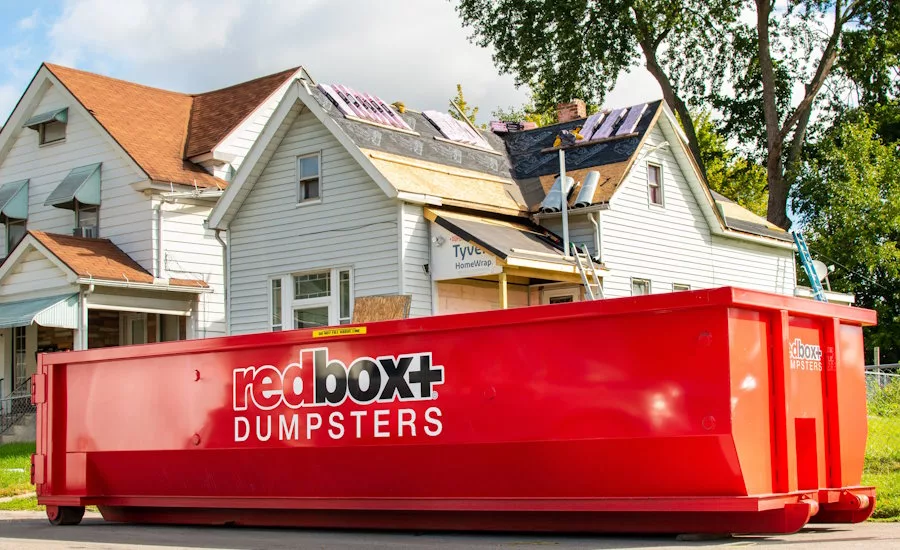Guest Column
Efficient Waste Management Keeps Roofing Projects on Track

Photo courtesy of redbox+.
Roofing projects generate debris, from loose shingles and insulation scraps to spent nails. When left to accumulate, this debris can make the jobsite difficult to navigate — potentially impeding the project’s progress. By contrast, a strategic approach to waste management boosts project efficiency, ensuring the new roof is completed without needless delay.
Roll-off dumpsters offer a proven solution for the efficient disposal of roofing waste, but choosing the right one involves more than a quick reservation. Roofers should consider size, material type, disposal guidelines and, most importantly, the reputation of the dumpster company they select before scheduling delivery.
Not All Dumpsters are Created Equal
When reserving a dumpster, it’s important to select a size that fits the job at hand. While different dumpster companies may offer slightly different size variations, standard options include:
- Small dumpsters (10-15 yards). In most cases, dumpsters in this range will be insufficient for a roof replacement. That being said, they may be worth considering for smaller-scale projects, such as repairs or installs on modestly sized homes. These dumpsters may also come in handy during the final stages of a project when you need a dumpster but don’t have a lot of materials to dispose of.
- Medium dumpsters (20-30 yards). This is the sweet spot for most roofing projects, including residential and smaller commercial jobs.
- Large dumpsters (40 yards). For projects that may generate vast amounts of waste — including expansive commercial projects — a large-size dumpster might be the best bet. Be aware that a 40-yard dumpster is suitable for most commercial roofing material disposal (EPDM, rubber, PVC, TPO), but is likely not suitable for asphalt shingles due to the weight of the material.
Indeed, while size is an important consideration when selecting a dumpster, weight matters too. When waste accumulation is mostly foam and other membrane roofing materials, this is seldom an issue — but for more extensive renovations that involve breaking up a concrete roof, or for projects that involve metal or tile roofing materials, it may require a heavy-duty dumpster to avoid overage fees and ensure safe transport.
Choosing the Right Dumpster Rental Company
When selecting a dumpster provider for your project, ensure the company can provide the dumpsters and services that your project requires.
As all roofers know, the initial tear-off phase of a roofing replacement creates significant waste that can fill up a dumpster quickly. Ensure your dumpster provider can provide quick swaps to avoid project delays.
Also, confirm that your dumpster provider guarantees quick turnaround times and allows you to pre-schedule dumpster drops, pick-ups and exchanges. Additionally, on asphalt shingle and tile roofing jobs, inquire whether your dumpster provider will sweep the area around where the dumpster is placed on the final pickup to remove any nails or other hazards that did not make it into the dumpster.
Choosing a responsive dumpster provider with quick service can make a roofing project much more efficient and profitable.
Recycling, Hazardous Materials and Other Special Concerns
Once the dumpster is in place, that doesn’t necessarily mean roofers should start piling it with waste; it’s important to discern different types of waste, keeping hazardous materials out of the dumpster and, if possible, recycling applicable materials.
Different municipalities will define hazardous materials in varying ways, but for roofing companies, the main materials to be aware of are particular types of insulation. It’s been decades since asbestos was widely used, but renovations of older buildings can still uncover it, especially near the roofline. Always check local regulations and consult with disposal experts when hazardous materials are suspected.
Cellulose insulation is also not permitted to be disposed of in standard dumpsters, mostly because of its fire-retardant design — though this, too, is rare, with most roofing projects utilizing foam or fiberglass. These insulation types are acceptable to place into a dumpster.
For projects with sustainability targets, it makes sense to separate materials and ensure recyclables don’t wind up in the dumpster with general waste and refuse. In addition to insulation materials, examples of roofing recyclables include wood, metal roofing panels, cardboard packaging and metal banding.
Efficient Waste Management: Tips and Best Practices
Having debris pile up on the jobsite, or overflowing from dumpsters, can not only impede efficiency but also make the jobsite less safe for workers and violate worker safety standards. As such, managing waste efficiently is imperative. Beyond selecting the right dumpster and being mindful of different waste materials, there are a few guidelines to keep in mind.
It’s important to handle different types of waste accordingly to ensure they don’t take up too much room in the dumpster — for example, larger pieces of wood can be broken down into smaller pieces. Removing nails can also be important, ensuring safety as items are transported and disposed of.
Schedule multiple pickups for projects that last longer than a day or two, ensuring the dumpster remains usable throughout the roofing project. Schedule pickups in advance, especially around major tear-off or demolition days. Avoid mid-demo pickups, which can disrupt workflow.
More than anything, it’s important to plan ahead, and not to leave waste management as an afterthought. Being proactive in selecting and reserving a dumpster can minimize any inefficiencies caused by waste pileups — enabling roofing crews to work at a productive pace.
Looking for a reprint of this article?
From high-res PDFs to custom plaques, order your copy today!





